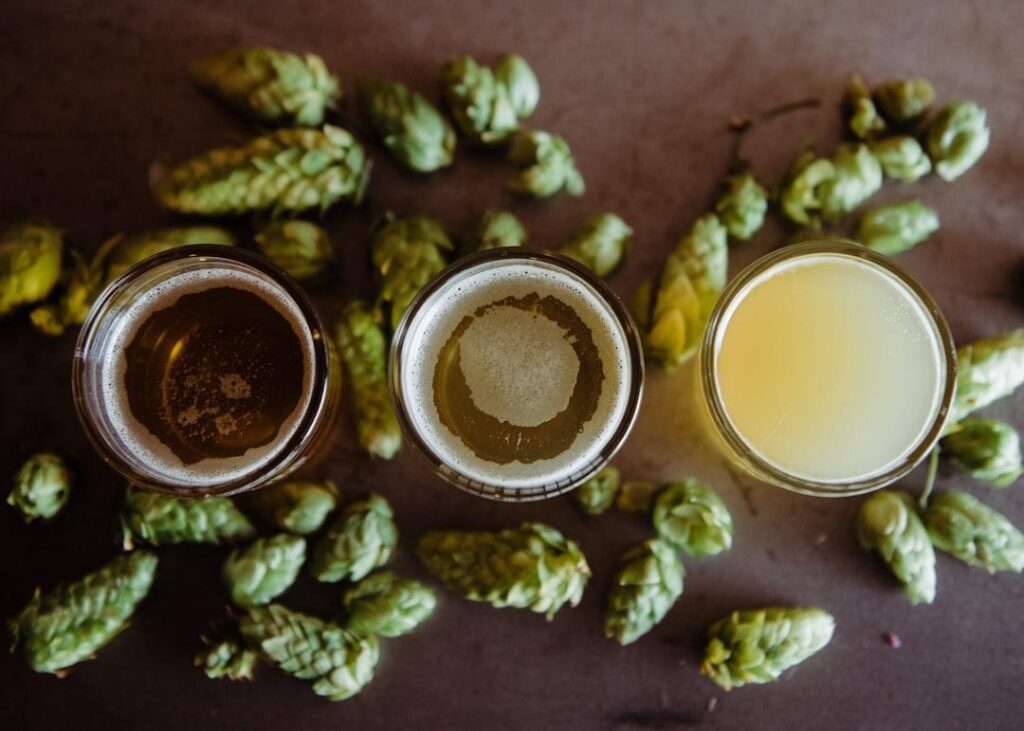Brewing craft beer is both an art and a science, combining precision and creativity to transform water, malt, hops, and yeast into a symphony of flavors.
Of those key brewing ingredients, today’s focus is hops.
You’ve probably heard of hops for beer making, but did you know about their critical role in creating beer’s distinctive flavor and aroma?
In Cincinnati’s vibrant craft beer scene, hops have taken center stage, as they can produce a diverse range of beers to suit every taste. This guide explains what beer hops are and explores six hops for brewing that create memorable and distinctive beers you might find at a Milford brewery.
What Are Hops in Beer?
Hops are cone-shaped flowers of the Humulus lupulus plant, a member of the hemp family. Although hops were traditionally used as herbal remedies for thousands of years, 98% of crops today are grown for the brewing industry. There are over 250 varieties of hops, accounting for a wide range of craft beer tastes, aromas, and flavor profiles.
A good way to think of hops in brewing is like spices in cooking. You can technically make craft beer without hops, but the resulting lack of flavor would leave much to be desired. While different factors can affect the taste of beer, hops account for a host of key characteristics, including:
- Clarity
- Flavor
- Aroma
- Preservation
- Foam quality
- Bitterness balance
- Shelf-life stability
The alpha and beta acids, oils, and resins in hops are responsible for the range of flavor profiles in beer, from floral and citrusy to earthy and piney. Hops also account for intense flavors and strong aromas, making them essential in craft beer brewing.
Dual Use, Bittering, and Aroma Hops
Craft brewers use hops to create beer’s distinct bitterness or provide its aromatic properties. Bittering hops are added in the earlier stages of the boil, followed by aroma hops (or noble hops), contributing to more subtle characteristics later in the process.
Many brewers also make beer with hops that have a dual purpose, balancing bitterness and aromatic features. Below, we look at six hops Cincinnati brewers love experimenting with.
Common Varieties of Hops Used by Cincinnati Breweries
Cascade
Jack Horner, a researcher in the USDA’s hop-breeding program, developed Cascade in 1972. The variety quickly became the poster child of American hops and one of the most popular hops of all time, accounting for 10% of all beers brewed in the country.
A favorite among Cincinnati brewers, Cascade is known for its distinct spicy, citrusy aroma with hints of grapefruit. The moderate alpha acid levels in Cascade hops make it a versatile option, perfect for brewing American pale ales (APAs) and India pale ales (IPAs).
Centennial
Centennial hops were created at the USDA-sponsored hop breeding program at Washington State University by mixing together four other hop varieties.
Released in 1990 and another all-star in the hops scene, Centennial is a dual-purpose hop similar to its Cascade cousin. The slightly higher alpha acid levels provide a stronger, more intense flavor with a heavier citrus and hops taste. This extra oomph in flavor is why Centennial hops are sometimes given the nickname “Super Cascade.”
This variety is celebrated for creating pale ales and IPAs with a forward aroma, offering a versatility in bitterness that makes them popular in commercial and craft brewing.
Chinook
Developed by the USDA in 1985, Chinook hops are another powerhouse and favorite in Cincy’s craft brewing scene.
Dual-use and suitable for any boil stage, Chinook’s high alpha acid content provides a spicy, piney, citrusy aroma that makes them ideal IPA hops. But Chinook is equally as common in other robust styles such as stouts and porters, and the distinct piney character also makes them suitable for pale ales, seasonal brews, winter ales, and barley wine.
Simcoe
Yakima Chief Ranches released this home-brew favorite in 2000.
Compared to household names like Cascade and Centennial, Simcoe hops are a relative newcomer to the scene, but they’ve become quick darlings amongst craft brewers.
The high alpha and low cohumulone acid levels in Simcoe hops make for a complex flavor profile that mixes fruity, earthy, and piney notes. Although brewers use Simcoe to create different styles of beer, it’s especially suited to brewing IPAs and has quickly developed a reputation as a foundational bittering hop.
Citra
John I. Haas, Inc. and Select Botanicals Group created and released the American Citra hops under the Hop Breeding Company in 2008 by combining four other varieties.
For beers with a distinctly tangy, fruity aroma, the Citra hop is perfect for elevating pale ale and IPA flavors and is one of the most common options in commercial, craft, and home brews.
The high myrcene content is responsible for Citra’s pungent flavor with hints of grapefruit, lime, and tropical fruits. With a relatively high alpha acid profile, Citra hops are suitable for bittering and creating aroma, and it’s common for brewers to combine Citra pellet hops with other varieties, such as Simcoe.
Amarillo
Amarillo is a relative newcomer on the hops scene. Though it was only released in 2014, it’s hardly a step behind in popularity.
For a finished beer with a distinct orange-citrus character and fruity, floral aroma, Amarillo hops deliver. Common in dark ales and all types of IPAs, including American, Imperial, and Belgian, Amarillo’s bittering, aromatic qualities, and unique flavor profile make them a popular dual-use option. Amarillo hops blend effortlessly with more established options such as Cascade and Centennial, giving them a versatile reputation, whether whole or in pellet form.
Visit Little Miami Brewing To Enjoy Expertly Crafted Beers
At Little Miami Brewing Company, we don’t just make beer; we craft it.
Every batch is carefully brewed and tested to create flavor profiles that entice, awaken, and delight your taste buds. Contact us to learn more about our story, check out some beer reviews, or find out about upcoming events.
Better yet, join us on the banks of the Little Miami River — where the Queen City’s rich history and Milford’s charm meet — for the finest craft beer Cincinnati has to offer.




